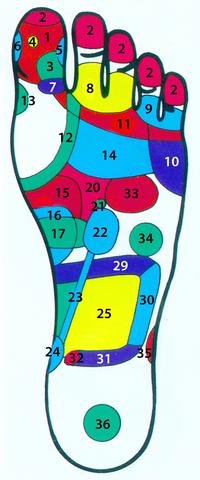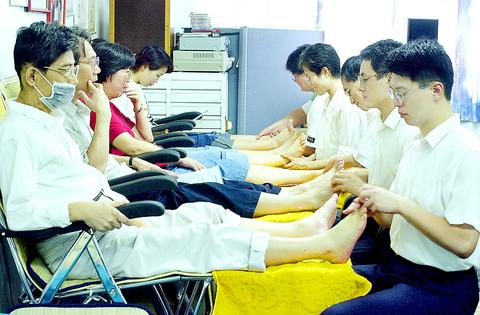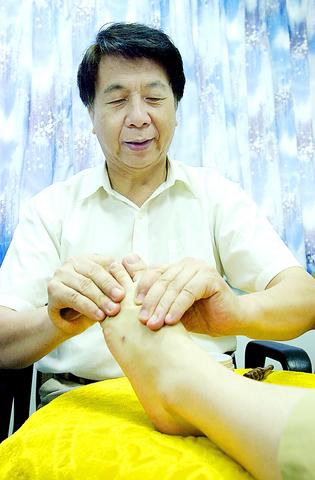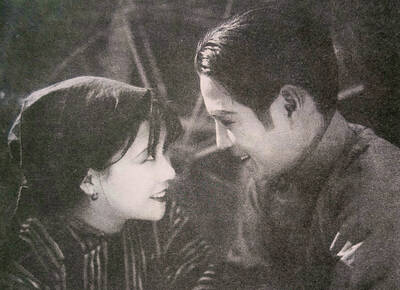Inside the long storefront windows lie a row of big comfortable couches on which a dozen customer are reclined. In front of them, massage therapists are concentrating on their customers' feet. Using only their hands, a wooden massage bat and some cream, they swiftly press, push and rub. Some of their Japanese customers give out groans of pain -- "Itai! Itai! Itai!" -- but most customers, foreign or local, seem to enjoy it. Three young Japanese women take pictures of each other while being massaged, their fingers stretched in a "V" gesture while their faces remain pinched in pain.
"Taiwanese foot massage is very famous in Japan. I heard it's more painful than in Thailand and other countries. I like it," said 24 year-old Yasuko Shishido.

Shishido was in Taipei for just a day and kept busy tasting local dumplings, sampling Oolung tea and pineapple cakes and was eager to get in a foot massage before having to leave Taiwan.

PHOTO: CHEN CHENG-CHANG, TAIPEI TIMES
"I come to Taiwan for business twice a year and always come here, however busy my trip," said 60-year-old Tuneo Iwane, another Japanese customer at this foot massage parlor.
For many Japanese tourists, Taiwan's attractions aren't only the Palace Museum and Chiang Kai-shek Memorial Hall, but the masochistic pleasure of foot massage.

PHOTO: CHEN CHENG-CHANG, TAIPEI TIMES
Walking along Taipei's Minchuan East Road or Linsen North Road, there can be seen more than a dozen foot massage parlors, each with a huge, eye-catching sign of a colorfully diagrammed foot. Many of them bear the name Father Wu Foot Massage.
Father Josef Eugster from Switzerland, who goes by the Chinese name Wu Ro-shih (吳若石), said the parlors and their popularity are something he would never have thought of 23 years ago, when foot massage was a simple self-help therapy. It was more than two decades ago when he "re-discovered" and began promoting the practice that can be found in the ancient histories of China and Egypt, a therapy known as foot reflexology.
A month ago he held a press conference clarifying to the public for the first time that he had never authorized anyone to use his name as a trademark, nor is the colorful foot diagram of his making. The phenomenal success of foot reflexology in Taiwan makes Eugster proud, but at the same time worried.
After arriving in Taiwan 30 years ago to preach in Taitung, Eugster became bothered by arthritis. Another Swiss priest gave him a book about foot reflexology titled Good Health for the Future (1976), by Heidi Masafret. He studied the book and experimented on himself. Pleased with the results, he began practicing on his disciples to help them with their own health problems, but also as a way to spread the gospel.
According to theories expounded on by Eugster and Eugene Cheng (
Reflexology theory divides the foot into 26 bones and five major reflex areas. To massage the foot is to stimulate the problematic organs or "push away the pathological sediments," Eugster said.
Cheng also combines reflexology theory with Chinese medicine's five-elements concept in practicing foot massage. For example, if one feels pain or sediment when pressing on one part of the left sole (see diagram, area 33), it is an indication of a heart problem. According to the five-elements theory, the heart belongs to the fire element, so in addition to the heart, the reflex areas of the intestine and liver must also be massaged in order to maintain a healthful balance.
After considerable local and international media coverage 20 years ago, Eugster gained fame and a flock of foot-massage followers. Shuttling from workshops to hospitals and speaking engagements, the fruit of Eugster's work can be seen in nearly every city in Taiwan, with around 1,000 foot massage parlors on the island, according to Cheng. And it's become more popular, losing its focus on therapy and becoming more of a superficial consumer fad.
It's also become a huge money-making enterprise lacking in regulation. Some parlors have developed into multi-function health centers. In addition to offering foot massage, one parlor called Tsai Chun Kuan (
Tsai Chun Kuan has also contracted with several travel agencies to bus tourists directly to the parlor. Tourists pay NT$700 for a half-hour foot massage, NT$200 of which goes to the travel agents. For Japanese, it's still a reasonable price compared with what they would pay in Japan.
Currently in Taiwan, the price for a foot massage is between NT$500 and NT$700 for 30 minutes. There is no regulation of price or quality, which can vary widely.
Lu Wan-ping (
Since 1984, the Cabinet-level Department of Health (
The ROC Foot Reflexology Association, founded by Cheng and Eugster, is the only group in Taiwan that certifies massage therapists in their chosen trade. But there remains a void of institutionalization on the correct practice and technique of foot reflexology, according to Cheng.
"If they want to use my name, they have to employ my standard of skill and quality of practice," Eugster said. "I'll have to train them myself."

Taiwanese chip-making giant Taiwan Semiconductor Manufacturing Co (TSMC) plans to invest a whopping US$100 billion in the US, after US President Donald Trump threatened to slap tariffs on overseas-made chips. TSMC is the world’s biggest maker of the critical technology that has become the lifeblood of the global economy. This week’s announcement takes the total amount TSMC has pledged to invest in the US to US$165 billion, which the company says is the “largest single foreign direct investment in US history.” It follows Trump’s accusations that Taiwan stole the US chip industry and his threats to impose tariffs of up to 100 percent

On a hillside overlooking Taichung are the remains of a village that never was. Half-formed houses abandoned by investors are slowly succumbing to the elements. Empty, save for the occasional explorer. Taiwan is full of these places. Factories, malls, hospitals, amusement parks, breweries, housing — all facing an unplanned but inevitable obsolescence. Urbex, short for urban exploration, is the practice of exploring and often photographing abandoned and derelict buildings. Many urban explorers choose not to disclose the locations of the sites, as a way of preserving the structures and preventing vandalism or looting. For artist and professor at NTNU and Taipei

March 10 to March 16 Although it failed to become popular, March of the Black Cats (烏貓進行曲) was the first Taiwanese record to have “pop song” printed on the label. Released in March 1929 under Eagle Records, a subsidiary of the Japanese-owned Columbia Records, the Hoklo (commonly known as Taiwanese) lyrics followed the traditional seven characters per verse of Taiwanese opera, but the instrumentation was Western, performed by Eagle’s in-house orchestra. The singer was entertainer Chiu-chan (秋蟾). In fact, a cover of a Xiamen folk song by Chiu-chan released around the same time, Plum Widow Missing Her Husband (雪梅思君), enjoyed more

From insomniacs to party-goers, doting couples, tired paramedics and Johannesburg’s golden youth, The Pantry, a petrol station doubling as a gourmet deli, has become unmissable on the nightlife scene of South Africa’s biggest city. Open 24 hours a day, the establishment which opened three years ago is a haven for revelers looking for a midnight snack to sober up after the bars and nightclubs close at 2am or 5am. “Believe me, we see it all here,” sighs a cashier. Before the curtains open on Johannesburg’s infamous party scene, the evening gets off to a gentle start. On a Friday at around 6pm,